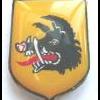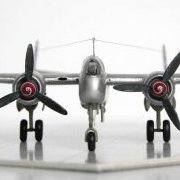Search the Community
Showing results for tags 'Junkers'.
-
Hello guys. As the title explains, are ICM's decals of the sticky nature? I don't want to find out that after having my model all gloss coated, only to find out the decals stick firmly to the surface as soon as they are placed. TIA!
-
This is the special edition of the Hasegawa kit, which includes some white metal parts for the 20mm cannons, flame damping exhausts and the different antenna for the top of the canopy. As usual the Hasegawa kits go together without much fuss with the decals and detail being just fine for this scale. I did add some seat belts to the kit though. The aircraft depicts one of Nachtschlachgruppe 9 in Italy that carried out night harassment raids against the allies. Camo was done free hand.
- 22 replies
-
- 41
-

-

-
Don't ask me what it is... AZmodel is to release a 1/72nd (Junkers ????) kit - ref. Source: https://www.facebook.com/azmodelkits/photos/a.478840912140523/2598691176822142/ V.P.
-
Hello all! Here are some photos of my recently completed model, Revell's Ju 88A-1 in 1:32. It was a fight from start to finish, some pieces, such as the rudder pedals, didn't live to see the end of the project. I take all that to my own poor construction methods. I won't build another 32nd bomber again.
- 19 replies
-
- 40
-

-
- Junkers
- Junkers ju 88
-
(and 1 more)
Tagged with:
-
Decided to start a side project, apart from Airfix's 1:48 Bf 109E. This photo is from earlier today. And this one is from today's evening. The camouflage has been outlined with a pencil. I had glue remaining just for the left engine cowling, I'll buy more tomorrow, if I can.
- 31 replies
-
- 3
-

-
Ju.290 Update Set (BRL72187 for Revell) 1:72 Brengun The Ju.290 Seeadler was a huge maritime reconnaissance aircraft that could also be pressed into service as a transport. It was chosen as a candidate for development into the proposed Amerika Bomber project that eventually fizzled out as the situation in Europe deteriorated. Less than 70 were built and none survived long after the war. Revell’s kit in 1:72 is as nice as it is large, and with its heritage beginning in 2003 it is a relatively modern tooling, but could do with some upgrading of the finer details to match modern standards and satisfy those interested in detail. This Photo-Etch (PE) set from Brengun is designed to improve on what Revell have given us by adding extra detail in all the right places. It arrives in a compact flat pack with a red Brengun themed header card and a sheet of black paper showing off the PE within. There are two frets of nickel-plated PE, plus a small slip of clear acetate with the instrument panel and gunsight on the mid-upper turret. The instructions are found behind the black paper, and construction begins with the rear turret, with interior detail in the canopy as well as within the opening into the fuselage, including a new set of ring sights at the tip of the barrel. Flipping to the front, the cockpit has a new set of instrument panels with the acetate rears depicting the dials, a new coaming, throttle quadrants, rudder pedals and other instruments on the sidewalls. The seats also get belts and a stowage pocket behind the right seat. The mid-upper is decked out with a brand new turret basket after removing the simplified tube that is provided in the kit, including instruments around the lip, ammo feed, and upgrades to the gun with the aforementioned gunsight. Externally, the main gear wells are adorned with a new bay skin, plus a new set of laminated bay doors and brake hose parts, while the airframe is given a make-over by replacing most of the antennae dotted around, including the whisker antennae on the nose, which will improve their look immensely. Lastly, the engines are fitted with a circular inner skin that gives the impression of depth and the cylinders behind the prop boss. As an aside, the picture of the PE wasn't taken in black and white, but came out looking that way for reasons best known to my scanner and how it reacts to the light reflecting off the metal. Highly recommended. Review sample courtesy of
-
Ju.52 Update Sets (For Revell) 1:48 Eduard Revell have recently re-released their still excellent Ju.52 Tante Ju kit (reviewed here), and Eduard have reciprocated by re-tooling their sets for the modern modeller. Eduard's new range of sets are here to improve on the kit detail in the usual modular manner. Get what you want for the areas you want to be more of a focal point. As usual with Eduard's Photo-Etch (PE) and Mask sets, they arrive in a flat resealable package, with a white backing card protecting the contents and the instructions that are sandwiched between. Update Set (49987) Two frets are included, one nickel plated and pre-printed, the other in bare brass. A complete set of new layered instrument panels, throttle quadrant and radio gear plus a new engineering panel are the primary parts on the painted set, with new rudder pedals; racks & brackets; controls inside the fuselage; machine gun and ammo can details; and even some bracing to the nose-mounted engine's exhausts are also supplied. Zoom! Set (FE987) This set contains a reduced subset of the interior, namely the pre-painted parts that are used to improve on the main aspects of the cockpit, as seen above. Whatever your motivations for wanting this set, it provides a welcome boost to detail, without being concerned with the structural elements. Seatbelts STEEL (FE988) In case you don't already know, these belts are Photo-Etch (PE) steel, and because of their strength they can be etched from thinner material, which improves realism and flexibility in one sitting. Coupled with the new painting method that adds perceived extra depth to the buckles and other furniture by shading, they are more realistic looking and will drape better than regular brass PE. As well as lap belts for the rest of the crew, the pilot has a four-point harness, and the rows of sideways-facing passenger seats have new lap belts added after removing all the moulded in representations from the whole aircraft. Passenger Seats (49988) This larger bare brass set two frets with a large floor skin for the passenger compartment, which is then decked out with two seats at the rear with recessed tops to accommodate parachute pack wearing crew. A set of grab handles are fitted to the inner fuselage sides, and two sets of twin seats are made up to line the sides, adding a substantial improvement in detail, and begging to be used in conjunction with the seatbelt set. Masks (EX655) Supplied on a sheet of yellow kabuki tape, these pre-cut masks supply you with a full set of masks for the canopy, with extra masks for the side windows and other glazing parts. In addition you get a set of hub/tyre masks for all the wheels, allowing you to cut the demarcation perfectly with little effort. Review sample courtesy of
-
Hi! Here are the photos of my latest work. It`s the ICM kit,which despite having received a lot of "flack" builds up into a beautifull model. It has several issues, mainly with the cockpit, but, after the glass work was installed, this modeller can live very well with it. paints utilised: Vallejo Model Air e acrílicos Mig. detailing sets: Eduard interior and exterior set If you have interest, you can find in my blog around 90 fotos with all the building and painting process explained. http://josepiresmodelismo.blogspot.pt/ This model was part of Airfix Model World mag, December 2017 issue.
- 40 replies
-
- 70
-

-

-
Junkers F.13 Conversion Set (MX 7222.07) 1:72 Master-X The Junkers F.13 was an all-metal, cantilever wing monoplane that was one of the most advance aircraft in the world when it first flew in June 1919. It was in production for 13 years - an incredible feat given the stupendous pace of aeronautical development throughout the early twentieth century. The aircraft was built around an aluminium alloy frame, with stressed skin in the classic Junkers style. The cockpit was only semi-enclosed, but the passenger compartment, which was fitted out to accommodate four people, was fully enclosed and heated. Over 322 examples were produced, with a great many different power plants finding their way into the airframe. This conversion set from Master-X is designed for the Revell kit - a stone cold classic from the German firm's 1990s purple patch. In the plastic bag, you get a replacement upper fuselage, horizontal and vertical tails, ailerons, wheels, propellor and lower cowling. The standard of casting is high and the rendering of the surface details means it will be a good match for the original kit. Of course the parts will need to be cleaned up prior to assembly, but from what I've seen, I wouldn't expect construction will present too many difficulties. Decals are included for the intended subject, an example used by the Eurasia Aviation Corporation in China in 1931. The colour scheme is a striking black, red and aluminium number. Conclusion This is a well-designed and nicely made conversion set which opens up new possibilities for Revell's excellent kit. The inclusion of decals is a necessity given the nature of the conversion, but one which makes this into a nice little project. An absolute must for fans of interwar aviation. Review sample courtesy of
-
Afternoon everyone. For my next project, I'd like to try and replicate the Ju88r found at the RAF Museum Cosford (formally at Hendon) in 1/72 scale. This particular airframe has a fascinating history, I'm sure many of you know already know it, and I'd like to try and get as close as possible to this, but alas know very little about the differences in specifications of the Ju88. Extra information on the aircraft can be seen here: https://www.rafmuseum.org.uk/cosford/whats-going-on/news/german-bomber-wings-its-way-to-the-midlands/ I already have the Revell Ju88C (as here: https://www.scalemates.com/kits/revell-04856-junkers-ju-88c-6-z-n--176229) and wonder what I would need to do to get as close as possible to the RAF Museum R model? I'd really appreciate any tips, guides or information anyone has on this! Thanks in advance Matt
-
I used to build a lot of WWI planes, some of them were vacforms . Time to have a go at one, no rigging on this one. Decals Three sprues of flashy parts, and there is some very little parts. Have assembled the engine and cockpit ready for paint tomorrow. Thanks for stopping by. Stephen
- 21 replies
-
- 11
-

-
As already announced in a ICM general thread ( http://www.britmodeller.com/forums/index.php?/topic/234974439-icm-148-junkers-ju-88a5dornier-do-17z/), the Ukrainian brand is to release a new tool 1/48th Junkers Ju-88A-5 kit in 2015 - ref.48232. Source - ICM 2015 catalogue : http://www.icm.com.ua/katalog/ Box art V.P.
-
For my second build which i will be doing consecutively with my Ju88 s-3 to enable painting to take place at same time (to save time ) i have chosen another 88 from low down in the stash pile ,the oldish Dragon Ju88 G-6 . I understand that this can be a tricky kit to build but i feel forwarned ! I will be using the Aims decal sheet Ju88 G-6 , mistel collection. I have chosen this one as i have a built Hasegawa Morgenstern and hope to have a more typical G-6 later in the coming months. have assembled a small selection of resin I have some CMK seats and Quickboost exhausts to come. I have made use of the "less than 25% built rule" to do some pre preparation on the kit prior to the start on the 7th may. basically iv removed and cleaned up some of the larger parts , suprising how long this can take The rest of the parts Now only the main course to get on the table
- 114 replies
-
- 8
-

-
- Berlin FuG240
- Junkers
-
(and 2 more)
Tagged with:
-
Hello! Here is my Anigrand Craftswork 1:144 Junkers EF.130 medium jet bomber project which I built back in 2008. It is in fictitious markings of 1./KG6 of the Luftwaffe. This kit was one of the bonus kits with the Horten Ho.XVIII kit, and it was my first all-resin kit build. Apart from the work in cleaning up the parts and getting them to fit, I added a couple of details to the cockpit and thinned the undercarriage doors considerably. The scheme was inspired on a real one I found on a Ju 188 of 1./KG6. The kit was mostly painted by brush with some varnish applied by airbrush. Thanks for looking Miguel
-
Here is Anigrand Craftswork's 1:144 resin kit of the Junkers EF.132 bomber project which I built in 2002. Markings are for a fictitious KG200 machine in the Luftwaffe. It was built mostly OOB with only the guns being replaced by thinner items. The undercarriage doors were thinned. It was all painted by brush except for the matt varnish which was applied with airbrush. Thanks for looking and all comments are welcome Miguel
-
My first experience with the Wingnut Wings kit is finished and I must admit it was a pure joy! I`ve used TaurusModels engine goodies and my own hand-carved propeller with a resin hub by ProperPlane. Painted mostly with Tamiya acrylics.
- 20 replies
-
- 33
-

-

-
Hello, So it happens that it`s the first WnW kit on my bench. I`m also going to build Bristol Fighter WnW with Aviattic decals simultaneously with this one. What can I say - it's simply awesome!! Love every second of the time I spent building it so far. The box picture is by Artro modelling (too lazy to take one on my own).
-
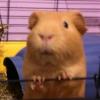
Wingnut Wings Junkers D.1 - 1:32 Wingnut Wings
Viking posted a topic in Ready for Inspection - Aircraft
Junkers D.1 - 1:32 Wingnut Wings This was one of Wingnut Wings surprise releases in April this year, few of us would have predicted that A Junkers D.1 was on the cards. Although Wingnut Wings are well known for producing beautifully engineered and presented kits, this one was so impressive when reviewed here it went straight onto my workbench, pushing all other projects aside. It hasn't disappointed, it is an absolute joy of a kit to build, pretty much flawless in every respect. The fit of parts is outstanding, virtually perfect, and there is no filler used at all, anywhere. Wingnut Wings kits are always outstanding, but this one probably tops the lot from all those I have built from their range so far. And with only one length of fishing line on the undercarriage. there is hardly any rigging either. The Junkers D.1 was the worlds first all metal monoplane fighter, and a hugely significant aircraft in the history of aviation. It arrived too late at the end of the First World War to have any real opportunity to prove itself, A few, perhaps four, were delivered to the western front, but most were delivered after the November 1918 Armistice. They saw post war service in the Baltic during 1919, with the German Freikorps fighting the Bolsheviks, where they were used to good effect. On with the photos; I've only lightly weathered, with a dark wash on various details and a bit of mud splatting on the underside. Cockpit details; To give an idea of its size, I've used that standard WW1 unit of comparison, an Albatros DV.a. The D.1 is surprisingly big. And a final comparison with Wingnut Wings other kit for a Junkers, the two seat J.1 ground attack machine. Those of you who have built one will know what a whopper of a model the J.1 is. Perfect companions; If you are thinking of trying a Wingnut Wings kit, but are wary of the biplane wing and rigging, then try this one. Cheers John -
Junkers D.1 1:32 Wingnut Wings. (#32065) As soon as this subject was announced, it caused a flurry of interest on various internet sites (including this one). Opinion seemed divided between those who felt that it was an insignificant aircraft with only forty built, and others who felt that it was a highly significant as the world’s first all metal monoplane fighter. Almost all agreed that it was a chunky little aeroplane, with opinions again divided between those who thought it ugly, and those who felt it had character. Right from the start, this seems to have been one of the most talked about of Wingnut Wings planned releases. History. Hugo Junkers method of metal tube structures covered with corrugated sheets had first been patented in 1912. Although there was an obvious weight penalty, all metal aircraft offered several advantages. Apart from being difficult to shoot down, probably the most unsung virtue was their serviceability. Wood, wire, and linen machines were very susceptible to poor weather, especially that encountered in the long winter months on the western front. Cold, wet, and damp could play havoc with these delicate airframes, at best degrading their performance and at worst making them unfit to fly. The two seat Junkers J.1 (Wingnut Wings kit 32001) had entered service in August 1917, and proved to be a popular and reliable machine. It was therefore logical that Junkers should also be working on a single seat fighter. What emerged from several prototypes and design variations was the D.1 which went into service in October 1918. There were 2 versions of the D.1, most commonly referred to as the ‘short’ and ‘long’ fuselage types. Without going into all the differences, it was the ‘short’ version that became operational, and is the one represented by this new kit. A few, perhaps four, were delivered to the western front, but most were delivered after the November 1918 Armistice. They saw service in the Baltic during 1919, with the German Freikorps fighting the Bolsheviks. The Kit. As always, the wonderful Steve Anderson artwork graces the silver edged Wingnut Wings box. Two D.1’s are depicted in flight against a backdrop of sunlit cumulus clouds. Lovely! It certainly exudes that ugly-but-aggressive look that makes it oddly attractive. Inside the box are four large sprues holding all the plastic parts, a small etched fret with the machine gun cooling jackets & seat belts, and a decal sheet. The instruction booklet follows Wingnut Wings excellent style of CAD drawings showing the assembly sequences, backed up with illustrations of what the completed sub-assemblies look like. These are supplemented with an amazing total of fifty one contemporary black & white photographs of the real aircraft, and a set of eleven colour photographs showing details of two preserved Daimler-Mercedes D.III engines. No wonder so many modellers regard Wingnuts Wings instruction booklets as reference manuals in their own right. They must put huge amounts of man hours into creating them, because they are so complete and no one does it better. Step 1 covers construction of the cockpit and engine bay. This is a fairly complex looking tubular structure, which is fitted to the single piece fuselage underside. The mouldings are breathtaking, particularly the centre section & wing spars part A30, which is a single piece; The finished article may look complex, but the core of this ‘birdcage’ framework is made up from only five parts (A7, A11, A12, A17, and A30). It is one of Wingnut Wings hallmarks that they can take intricate structures like this, and make them into easy to assemble units. I couldn't resist, and already started it. Dry fitted with no glue, the fit is excellent; Various other details such as bulkheads, seat, controls, and instruments are added to finish off the main interior. A small amount of rigging can be added if the modeller wishes, a diagram is provided to show what and where. These are for the engine control rod, rudder, throttle, and trigger cables. Five amp fuse wire will be the ideal material for the cables, with short lengths of stretched sprue for the rudder pedal lines. A very helpful CAD drawing shows the completed sub-assembly in full colour, thus also working as a painting guide. Step 2 details assembly of the Daimler-Mercedes D.IIIa / D.IIIau engine, the main differences being the intake manifolds and air pumps. As mentioned before, eleven full colour photographs support the assembly drawings, and again we have full colour CAD drawings of both sides of the completed engine. Wingnut Wings engines are the centre piece of any model, and this one will be visible more than most with those big removable cowling panels. I usually add ignition wires from the magnetos to the spark plugs, it is not difficult to do but is time consuming. No doubt etched brass aftermarket sets will be available soon to simplify this job. The D.IIIau is the high compression version of the engine, and was marked with red bands around the cylinders. These are provided as decals, along with tiny black & silver data plates that are affixed to the crankcase. Step 3 sees the fuselage brought together in a most ingenious way. The underside already has all the interior work fixed to it, and now the left and right sides are attached to it. These sides have a false top & bottom, so they are shaped like any normal kit fuselage, but the beauty is that the joining seams are hidden. On the bottom the main underside piece covers it, and the top seam is covered by a separate fairing from the cockpit to the tailplane. Not just one fairing, there is a choice of two, with slight detail variations in the style of corrugation and a roll over hoop depending upon which version you have chosen. It is attention to the minor details such as this that make these kits such a pleasure to build. Fitting the tailplane, radiator, and exhaust completes this stage. Step 4 is fairly simple, involving just the assembly of the wings. Here you are offered the choice of actually fitting them to the aircraft, or leaving them off. This is not quite as odd as it may at first seem, as there are plenty of photographs of D.1’s with their wings detached on the ground nearby. Given the small size of the finished model, there is plenty of scope for some neat little dioramas. You will have to decide to build with the wings ‘on’ or ‘off’, as changes to the wing stubs mean it will not be possible to pop them off and on. The ‘off’ version exposes a lot of the neat ‘birdcage’ assembled in stage 1, complimented by a pair of interior wing ribs to fit on the ends of stub wings. Step 5 is for adding some of the smaller exterior details such as the foot steps (choice of two), rudder, and LMG 08/15 Spandaus with their flash guards over the engine. Etched brass cooling jackets are provided, which will need to be annealed (briefly heated red hot in a gentle flame and left to cool) and rolled to shape. If you are not confident in doing this, then solid plastic alternatives are provided. As with the engine, the Spandaus are going to be much more visible than on a biplane, so are well worth taking time over. Step 6 completes construction of the D.1. The undercarriage, cockpit coaming, engine panels, and propeller are all fitted. Two short bracing lines are fitted between the rear undercarriage legs, and that’s it, there is no more rigging to do! Options. Al selection of five different machines is offered, four wartime and one post Great War machine serving with the German Freikorps in Latvia. Junkers D.1 5185/18, Aldershof, October 1918. Junkers D.1 5185/18, ‘Bänder’, Hombeek, MFJG, November 1918. Junkers D.1 “Weisser Schwanz”, Hombeek, MFJG, November 1918. Junkers D.1 5188/18? “11”, October 1918. Junkers D.1, Gotthard Sachsenberg (31 victories), Theodore Osterkamp (38 victories) & Josef Jacobs (48 victories), FA 416, September-October 1919. Decals. Decals are by Cartograf, so are of a very high standard. All printing is pin sharp with good colours and minimal carrier film. Plenty of small stencils, instruments and details are provided, along with the larger national and individual markings. The coloured bands on option B ‘Bänder’ are not known with absolute certainty, although red & white is thought most likely. However, should you disagree, green & white, yellow & white, and black & white are also provided. Conclusion Every new Wingnut Wings kit is waited for with great anticipation, and they never disappoint, by virtue of their being so well thought out and engineered. Announcement of this one seemed to cause a few grumbles out there on the ‘net, mainly along the lines of ‘why can’t we have an XYZ’. Well this is a hugely significant aircraft, being the world’s first all metal monoplane fighter, and deserves a place in any collection of 1:32nd aircraft models. It will be the perfect companion to the Wingnut Wings two seater Junkers J.1 (one of my favourite finished models of all the range). As well as in a Great War collection, the Junkers D.1 would sit very well against almost any Me/Bf 109 model. In fact this could be done for option E, as Theodore Osterkamp went on to fly the 109E with JG 51 in the Battle of Britain, scoring six more victories to add to his previous thirty two. They would indeed make a very interesting pairing. The quality of the mouldings ,particularly the representation of the corrugations is outstanding. It has been done with such finesse, with tiny little rivet detail and perfectly rounded ends to each line. The clever breakdown of the fuselage parts should make assembly very simple, with almost no, to minimal clean up. If you have been thinking of getting a Wingnut Wings kit but been put off by rigging, this is probably the best one yet for a novice to build. There are no clear parts, no complicated strutting, and only two little rigging lines on the undercarriage that can easily be done with fine wire or stretched sprue. Add to that that this is a Wingnut Wings package with all the quality that the name assures, this pugnacious and interesting little aeroplane deserves to be high up on everyone’s ‘wants’ list. I am so impressed and enthused by it, that it is going straight on to my workbench to be my number one build project. Look out for its imminent appearance in the ‘Work in progress’ section of this forum. <EDIT> Here it is in Work In Progress </EDIT> <EDIT> And the finished model is now in Ready for Inspection </EDIT> Highly recommended. Review sample courtesy of
-
Hi all, Kit manufacture: Revell Scale: 1/72 Type: Junkers JU 88A-4 Extras used: OOB except brass rod pitot and EZ line antenna Paints and colours used: Vallejo RLM colours (older type). Weathered with Flory Grime, and oil paints. All sealed with Aqua Gloss and flattened with Xtracylix matt varnish. I finished this one a little while ago but have only just got round to photographer her.A good kit this with generally good fit, but a couple of challenging areas. The wingtips being one of them... Beautiful surface detail though, and a wonderfully detailed cockpit.Here's the pics: That's about it. Thank you for stopping by! As always, comments, criticism and advice is always welcomed!Val
- 31 replies
-
- 63
-

-
Junkers J.1 1:32 Wingnut Wings Popular with is crews. the Junkers J.1 was designed for ground attack, and featured a steel armoured 'bathtub' that formed the forward fuselage, protecting the engine and two crew members. The rest of the aircraft was build from duraluminium tubing, covered with corrugated duraluminium sheeting. Rather than using cables & pulleys for the controls, it had rods and bell cranks to connect to the ailerons, elevator, and rudder, which were not so prone to being severed by machine gun fire.For the same reason no wire rigging was used, instead a very strong central structure was formed from tubing. Some aircraft were fitted with downward firing machine guns, but they were found to be cumbersome and awkward to aim, so most J1's were used for low level reconnaissance and Army co-operation. All in all it was very advanced machine for it's day, and was the first all metal mass produced aircraft. It was one of Wingnut Wings first four releases and whilst many subsequent kits have sold out, the J.1 is still available. This suggests that it has not sold as strongly as some of the others, and in fact I had it low down on my own priority list of which Wingnuts kits to buy. I finally got round to getting one last Christmas, fearing that it might sell out soon, and leave me regretting not getting one. I am really glad that I did, because once I had the kit in my hands it went right to the top of my 'to do' list. The surface detail is beautifully done, and the finished model has a real 'presence' to it. It is huge! It dwarfs any other single engined model and has become one of my favorites. There is a minor problem to redress though (probably the only one in Wingnut Wings entire range), as an error was made with the length of the ailerons, resulting in a gap at their inner end. There are several suggested fixes on the internet I went with This one using spare parts D24 & D25 in the kit for a simple and easy correction. The LVG C.VI is a big model, but is dwarfed by the J.1; It easily comes apart for storage too! As always, I thoroughly enjoyed this build. If you have been dithering about getting one of these, like I was, don't hang about, get one ordered! You'll get to love it, it has got a sort of ungainly beauty about it just like its modern successor the A-10 Warthog. Thanks for looking, John
-
The Junkers Ju287 first flew in August 1944. It was built as a ‘Technology demonstrator’ to test the swept forward wing. In order to get a working prototype into the air as quickly as possible the new wing was fitted to the fuselage of a Heinkel 177, the tailplane and rudder came from a Ju188 and 388 and the fixed undercarriage was taken from a captured B24! The basic model went together quite well, aided by Huma’s technique of moulding tongues on to the wing roots which join together to ensure that the dihedral is correct. Problems start when adding the ancillary bits. The fuselage mounted engines have two problems. The a/c engines are ‘toed in’ slightly, presumably to keep the exhaust away from the fuselage side but the model’s engines are not and need correction. There is also a fairing between the engine and fuselage which needs adding to the model. The u/c legs supplied with the model are simple struts but need fitting with fairings. A hole needs to made in the rear end of the fuselage to represent the housing for the tail parachute. About 15gm of nose weight is needed. I added this after assembly by putting it through the access door on the underside followed by a dollop of Milliput to keep it quiet. The legs for the nose gear are very weak. I managed to break them off where they exit the ‘trouser’ fairing and had to rebuild using brass tube. A strut connecting the rear of the fairings needs to be added. This confers some extra stiffness to the assembly. I could not get the RATO units to fit using the parts supplied, nor could I work out just what the supporting structure looked like so something was cooked up using brass tubes. Having fitted the units I then discovered that it was impossible to paint the supporting structure! There is a strange pattern on the side of the a/c which, apparently, uses sensitive paint to detect the temperature increase due to the engine exhaust impinging on the fuselage. I have not been able to determine whether this appeared on both sides, or just one. I went for just one and made a decal to represent it, the colour of which is totally spurious as nobody knows what the real thing looked like. When applying the fuselage decals I decided to try using ‘Kleer’ to hide the carrier film and failed miserably. Any ideas on why it went wrong? One last point. A book on the Ju287 published by Ian Allan contains some very nice looking coloured drawings purporting to represent the a/c at the time of its first flight. Unfortunately the colour scheme is not consistent from view to view and does not seem to match the photos. I discovered that one of the authors runs the ‘Luftwaffe Experten’ website so I attempted to discuss the matter with him via a PM but he refused to answer and ended the conversation. Hmmm! Ju287V1_2014_05_06_28 by johnrieley, on Flickr Ju287V1_2014_05_06_36 by johnrieley, on Flickr Ju287V1_2014_05_06_34 by johnrieley, on Flickr Late addition This what the RATO unit and its support should look like - picture taken at Cosford RATO unit by johnrieley, on Flickr Photo is courtesy of Richard Griffiths at Griffiths Models and Books. His site is worth a look as there are lots of photos https://www.facebook...fithModelsBooks Here are a couple of other pictures that I had forgotten about (on my wife's camera) This shows the adjustment to the engines to get the correct thrustline Engine toe in by johnrieley, on Flickr The second shows the cockpit interior - most of which is invisible when the front section is added. I had thought with all that transparency much more would be visible. Ju287 cockpit by johnrieley, on Flickr John
- 27 replies
-
- 29
-


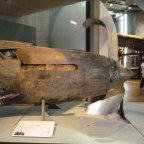
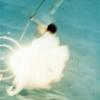




.thumb.jpg.68dbfcb7df45418b1b83fc1e5bd88ea5.jpg)

